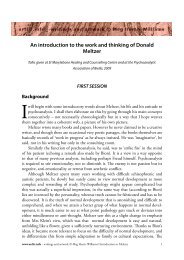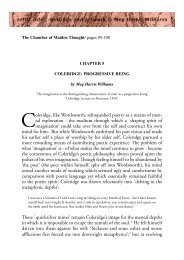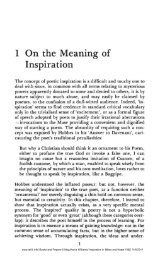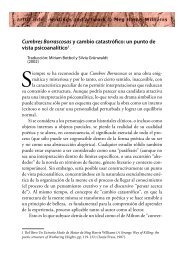Genesis of the 'aesthetic conflict' by Meg Harris Williams ... - Artlit
Genesis of the 'aesthetic conflict' by Meg Harris Williams ... - Artlit
Genesis of the 'aesthetic conflict' by Meg Harris Williams ... - Artlit
You also want an ePaper? Increase the reach of your titles
YUMPU automatically turns print PDFs into web optimized ePapers that Google loves.
29/01/2012<strong>of</strong> language, and <strong>the</strong> nature <strong>of</strong> aes<strong>the</strong>tic appreciation as explored in particular <strong>by</strong>Adrian Stokes. Meltzer (though not himself a poetry-reader) was very well-readin linguistics and his preoccupation with symbol-formation is evident in DreamLife (1983) and Studies in Extended Metapsychology (1986), and in somelater papers. The influence <strong>of</strong> <strong>the</strong> major poet-philosophers such as Shakespeare,Milton and <strong>the</strong> Romantic poets on <strong>the</strong> psychoanalytic model <strong>of</strong> <strong>the</strong> mind I havedescribed in detail in o<strong>the</strong>r books (The Chamber <strong>of</strong> Maiden Thought, The Vale<strong>of</strong> Soulmaking); thinkers such as <strong>the</strong>se wrote poetry because (as Bion said) itwas ‘<strong>the</strong> most serious way <strong>of</strong> writing’. The essay on Hamlet, ‘The undiscover’dcountry: <strong>the</strong> shape <strong>of</strong> <strong>the</strong> aes<strong>the</strong>tic conflict in Hamlet’, was written for this bookat Meltzer’s request. The poetry analysis that originally went into <strong>the</strong> formation <strong>of</strong>‘aes<strong>the</strong>tic conflict’ however was my doctoral dissertation work from <strong>the</strong> 1970’s onInspiration in Milton and Keats, which became my first book (1982).Both Milton and Keats are exceptionally direct, explicit and sensuous in<strong>the</strong>ir depiction <strong>of</strong> <strong>the</strong> Muse (internal object). The link with <strong>the</strong> infant’s love-hateresponse to <strong>the</strong> mo<strong>the</strong>r’s ambiguity became clear, as did <strong>the</strong> idea <strong>of</strong> <strong>the</strong> combinedobject lying behind all o<strong>the</strong>r symbols (and <strong>the</strong> creative artist’s sense <strong>of</strong> service to it,on behalf <strong>of</strong> humanity); also <strong>the</strong> drive for knowledge and awareness <strong>of</strong> <strong>the</strong> pitfalls<strong>of</strong> false knowledge. Words as signs are liable to be an invention <strong>of</strong> <strong>the</strong> poet’s ego(Bion’s ‘lies’), a manipulation or even a claustrum. By contrast, exploration anddiscovery take place under <strong>the</strong> aegis <strong>of</strong> <strong>the</strong> Muse or object. The task <strong>of</strong> <strong>the</strong> poet isto create <strong>the</strong> container, <strong>the</strong> apparatus for receiving thoughts – <strong>the</strong> ‘wreathèd trellis<strong>of</strong> a working brain’ as Keats described it.This information about <strong>the</strong> poets’ model <strong>of</strong> <strong>the</strong> mind was not derived fromwhat is usually termed ‘psychoanalytic criticism’ – imposing an interpretive schemein a way that (as Bion says) ‘victimises’ literature. Ra<strong>the</strong>r, it arose from a mode <strong>of</strong>reading which has analogies with <strong>the</strong> way <strong>the</strong> transference works in <strong>the</strong> psychoanalyticprocess.The mode <strong>of</strong> reading that has an organic ra<strong>the</strong>r than a reductive relationshipwith psychoanalysis is founded on a syn<strong>the</strong>sis <strong>of</strong> two methodologies which aresometimes seen as contradictory. On <strong>the</strong> one hand, it requires <strong>the</strong> kind <strong>of</strong> techniquesfor analysing poetic diction that I. A. Richards formalised in <strong>the</strong> Cambridgeschool <strong>of</strong> ‘Practical Criticism’ – techniques <strong>of</strong> ‘close reading’; and on <strong>the</strong> o<strong>the</strong>r,it also depends on a‘reader-response’ or ‘New Critical’ awareness <strong>of</strong> <strong>the</strong> reader’ssubjectivity as developed in <strong>the</strong> American schools <strong>of</strong> literature. Ultimately, thissyn<strong>the</strong>sis goes back to Coleridge, whose philosophy <strong>of</strong> symbol-formation madeexplicit how in poetry, <strong>the</strong> objective and subjective fuse at <strong>the</strong> moment <strong>of</strong> knowledge.Meltzer summarised <strong>the</strong> need to join psychological and structural approachesin a note he wrote for <strong>the</strong> jacket cover <strong>of</strong> Inspiration in Milton and Keats:www.harris-meltzer-trust.org.uk/ papers © <strong>the</strong> author 2
29/01/2012thinking – in which <strong>the</strong> thoughts pre-exist <strong>the</strong> thinker – is <strong>the</strong> opposite <strong>of</strong> <strong>the</strong>traditional view in which <strong>the</strong> thinker thinks up (invents) thoughts. It fits very well,however, with <strong>the</strong> poets’ concept <strong>of</strong> ‘inspiration’ and <strong>the</strong> relation with <strong>the</strong> Musethat this entails. As Meltzer put it in a talk on creativity: 1A creative genius is someone who permits his own internal objects to givehim new ideas - even if he does not understand <strong>the</strong>m or cannot use <strong>the</strong>m;his function is to receive <strong>the</strong>m, and he possesses <strong>the</strong> art <strong>of</strong> transmitting<strong>the</strong>m... Invention is a function <strong>of</strong> <strong>the</strong> self - discovery, a function <strong>of</strong> <strong>the</strong>creative self.(Meltzer, ‘On creativity’, 1992, in M. H. <strong>Williams</strong>, The Vale <strong>of</strong>Soulmaking, 2005, p. 175)This takes us back to <strong>the</strong> link with infant observation that underpins <strong>the</strong> ‘aes<strong>the</strong>ticconflict’, where poet-and-muse join hands with ba<strong>by</strong>-and-mo<strong>the</strong>r. The poetsdemonstrated that inspiration depends on aes<strong>the</strong>tic reciprocity, and this has to bere-established each time with each new poem, each new phase in development.It cannot be taken for granted; reparation is not under <strong>the</strong> ego’s control – it is afunction <strong>of</strong> <strong>the</strong> internal object. The Oxford academics, as Meltzer said, did not‘have <strong>the</strong> concept’, so <strong>the</strong>y could not see <strong>the</strong> evidence – it was un-thinkable. Yet,from <strong>the</strong> psychoanalytic vertex, inspiration with its clear recognition <strong>of</strong> knowledgecoming from outside <strong>the</strong> self is probably a more accurate description than Kleinian‘reparation’ for <strong>the</strong> internal orientation underlying ‘<strong>the</strong> force that through<strong>the</strong> green fuse drives <strong>the</strong> flower’ (Dylan Thomas). It is <strong>the</strong> key to learning fromexperience:The integrated internal combined object learns from experience inadvance <strong>of</strong> <strong>the</strong> self and is almost certainly <strong>the</strong> fountainhead <strong>of</strong> creativethought and imagination.(Meltzer, The Claustrum, 1992)This applies equally to <strong>the</strong> ‘creative genius’ and to <strong>the</strong> earliest internalisation <strong>by</strong>every ba<strong>by</strong> <strong>of</strong> <strong>the</strong> combined object in <strong>the</strong> form <strong>of</strong> <strong>the</strong> enigmatic mo<strong>the</strong>r. Meltzerdescribed how accompanying Martha <strong>Harris</strong> to her supervisions <strong>of</strong> ba<strong>by</strong> observationat weekends in Italy, during <strong>the</strong> 1970’s, influenced his model <strong>of</strong> psychoanalysis:Perhaps it has been <strong>the</strong> experience <strong>of</strong> listening to mo<strong>the</strong>r-ba<strong>by</strong> observation seminarsin <strong>the</strong> last few years that has so impressed on me <strong>the</strong> inadequacy <strong>of</strong> <strong>the</strong> psychoanalyticmodel…to describe <strong>the</strong> nuances and complexities <strong>of</strong> that primary relationship(Meltzer, ‘Money-Kyrle’s concept <strong>of</strong> misconception’, p. 503)1 In 1992-93 Donald Meltzer and I gave a series <strong>of</strong> joint talks on creativity in Stavanger,Barcelona and Biella , based on The Apprehension <strong>of</strong> Beauty.www.harris-meltzer-trust.org.uk/ papers © <strong>the</strong> author 4
29/01/2012While Bion’s <strong>the</strong>ory <strong>of</strong> thinking proposed a view <strong>of</strong> mo<strong>the</strong>r-ba<strong>by</strong> communicationbased on ‘speculative imagination’ (as he called it), infant observation as a disciplinewas an art-science like psychoanalysis itself. The analogy with <strong>the</strong> ‘aes<strong>the</strong>ticcriticism’ <strong>of</strong> poetry and its focus on <strong>the</strong> minutiae <strong>of</strong> poetic diction in <strong>the</strong> widerprocess <strong>of</strong> symbol-formation became more understandable and mutually enhancing.It followed naturally ‘as <strong>the</strong> leaves to a tree’ (to cite Keats on poetry) that <strong>the</strong>reshould be a complementary inquiry into <strong>the</strong> nature <strong>of</strong> psychoanalysis as an artform in itself (see The Aes<strong>the</strong>tic Development, 2010). Again this was not a newsuggestion (it is in both early Meltzer and Bion), but <strong>the</strong> link with ano<strong>the</strong>r verbalart form gave it shape and substance.Finally, to return to Meltzer’s aes<strong>the</strong>tic ‘family tree’, what completed <strong>the</strong> picture<strong>of</strong> an organic evolution was <strong>the</strong> clinical work he and o<strong>the</strong>rs did with autisticchildren, whose frequently artistic sensitivity led <strong>the</strong>m to recoil from <strong>the</strong> impact<strong>of</strong> <strong>the</strong> aes<strong>the</strong>tic object, as summarised at <strong>the</strong> end <strong>of</strong> Studies in Extended Metapsychology(p. 207). This refined <strong>the</strong> picture <strong>of</strong> <strong>the</strong> container-contained within<strong>the</strong> psychoanalytic transference, making it clear that it was <strong>the</strong> ‘fitting toge<strong>the</strong>r’<strong>of</strong> <strong>the</strong> analyst’s attention and <strong>the</strong> patient’s co-operativeness, that constituted <strong>the</strong>container and made <strong>the</strong> psychoanalytic process itself into <strong>the</strong> aes<strong>the</strong>tic object. Theanalyst who, like <strong>the</strong> poet, <strong>the</strong> artistic literary critic, or <strong>the</strong> ba<strong>by</strong>-observer, can be‘divested <strong>of</strong> <strong>the</strong> expectation <strong>of</strong> knowing’, is in a position to apprehend how <strong>the</strong>process <strong>of</strong> coming-to-knowledge is itself an aes<strong>the</strong>tic experience. It is governed <strong>by</strong>what Bion calls ‘O’, <strong>the</strong> mystery <strong>of</strong> an object which lies beyond and detached from<strong>the</strong> mind <strong>of</strong> ei<strong>the</strong>r patient or analyst, reader or poet. Meltzer calls it a ‘conversationbetween internal objects’.These paths to knowledge dovetailed to produce <strong>the</strong> concept ‘aes<strong>the</strong>tic conflict’.So it is not <strong>the</strong> word – <strong>the</strong> term ‘aes<strong>the</strong>tic conflict’ – that is <strong>the</strong> new idea; it is itsnew life in <strong>the</strong> context <strong>of</strong> clinical psychoanalysis. The idea takes root and changes<strong>the</strong> perspective <strong>of</strong> <strong>the</strong> entire operation. Meltzer called it ‘<strong>the</strong> new psychoanalysis’.www.harris-meltzer-trust.org.uk/ papers © <strong>the</strong> author 5










